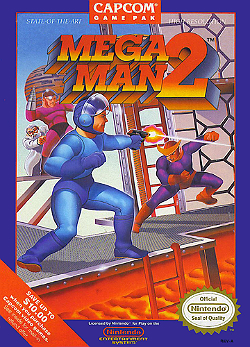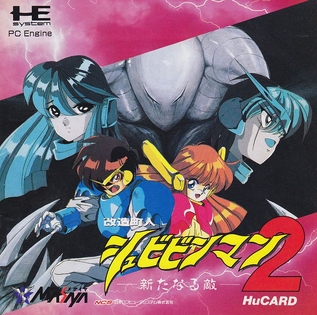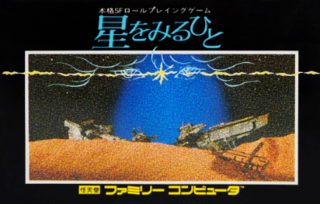
Mega Man 2 is a 1988 action-platform game developed and published by Capcom for the Nintendo Entertainment System. It was released in Japan in 1988 and in North America and PAL regions the following years. Mega Man 2 continues Mega Man's battle against the evil Dr. Wily and his rogue robots. It introduced graphical and gameplay changes, many of which became series staples.

Famitsu, formerly Famicom Tsūshin, is a line of Japanese video game magazines published by Kadokawa Game Linkage, a subsidiary of Kadokawa. Famitsu is published in both weekly and monthly formats as well as in the form of special topical issues devoted to only one console, video game company, or other theme. Shūkan Famitsū, the original Famitsu publication, is considered the most widely read and respected video game news magazine in Japan. From October 28, 2011, the company began releasing the digital version of the magazine exclusively on BookWalker weekly.
1991 saw many sequels and prequels in video games, such as Street Fighter II, Final Fantasy IV, Super Castlevania IV, Mega Man 4, Super Ghouls 'n Ghosts, and The Legend of Zelda: A Link to the Past, along with new titles such as Sonic the Hedgehog, Battletoads, Lemmings, Sunset Riders, Duke Nukem, Fatal Fury: King of Fighters, and Streets of Rage. The year's highest-grossing video game worldwide was Capcom's arcade fighting game Street Fighter II. The year's best-selling system was the Game Boy for the second year in a row, while the year's best-selling home video game was Sega's Sonic the Hedgehog, which was also the year's top video game rental in the United States.
1986 saw many sequels and prequels in video games, such as Super Mario Bros. 2, along with new titles such as Arkanoid, Bubble Bobble, Castlevania, Dragon Quest, Ikari Warriors, The Legend of Zelda, Metroid, Out Run and R.B.I. Baseball. The year's highest-grossing arcade video games were Hang-On in Japan, Hang-On and Gauntlet in the United States, and Nemesis (Gradius) in London. The year's best‑selling home system was the Nintendo Entertainment System (Famicom) for the third year in a row, while the year's best-selling home video games in Western markets were Super Mario Bros. in the United States and Yie Ar Kung-Fu in the United Kingdom.

Little Samson is a 1992 action–platform video game developed by Takeru and published by Taito for the Nintendo Entertainment System (NES). The game stars four heroes summoned to stop the demon king Ta-Keed from wreaking havoc on the kingdom of Forgy. Each hero has different abilities and the player can switch between the four at any time.

Famicom Wars is a turn-based strategy video game developed by Nintendo and Intelligent Systems and published by Nintendo for the Family Computer. It was released on August 12, 1988, in Japan. It was later re-released on Virtual Console. It is the first game in the Wars series.

Rockman EXE 4.5 Real Operation is a 2006 tactical role-playing game developed by Capcom for the Game Boy Advance (GBA) handheld game console. It is a spin-off title in the Mega Man Battle Network sub-series of Mega Man video games. The game was released in Japan on August 6, 2004, but was not localized or released in other territories.

Quiz Nanairo Dreams: Nijiiro-chō no Kiseki is a Japanese video game developed by Capcom. The game is a hybrid of a quiz game and a dating sim.

Wardner is a side-scrolling platform game developed by Toaplan and published in arcades worldwide by Taito in 1987.

Ys II: Ancient Ys Vanished – The Final Chapter is a 1988 action role-playing game developed by Nihon Falcom. It is a sequel to Ys I: Ancient Ys Vanished and takes place immediately following it. The game first released for the PC-8801 and PC-9801 and has seen several ports and remakes since.
Asuka 120% (あすか120%), subtitled Burning Fest., is a Japanese bishōjo fighting video game series from FamilySoft. It is set in a school where members of school clubs fight each other in a fighting tournament. Originally released on the FM Towns home personal computer in 1994, Masatoshi Imaizumi led development with artwork provided by manga artist Aoi Nanase and music by Keishi Yonao. Fill-in-Cafe developed it and its four follow-ups: Excellent (1994) on the same platform, later remade for PlayStation in 1997; Maxima (1995) on PC Engine; Special (1996) on PlayStation; and Limited (1997) on Sega Saturn. Success then developed an additional two titles: Final (1999) on PlayStation and Return (1999) on Windows. New entries in the Asuka 120% series have been announced in the 2020s although are yet to be released.

Cyber Citizen Shockman 2: A New Menace is a 1991 video game developed by Winds and released exclusively for the TurboGrafx-16. It was released in the United States in 1992 as just Shockman, making it the only original release in the Cyber Citizen Shockman series to be released outside Japan.

Dragon Slayer: The Legend of Heroes II is a 1992 role-playing video game by Nihon Falcom. It is part of the Dragon Slayer series and the second entry in The Legend of Heroes subseries. The game first released for the NEC PC-8801 before being ported to the NEC PC-9801, FM Towns, PC Engine, Mega Drive, Super Famicom and MS-DOS.

Nostalgia 1907 is a 1991 adventure video game developed by Takeru, and published by its label Sur Dé Wave. Originally released for the Sharp X68000, it was later ported to the FM Towns Marty, PC-9801, and Sega Mega CD. The player assumes the role of a passenger aboard a cruise liner named the Nostalgia that has been taken captive by a criminal looking for an artifact.
POI SOFT Co., Ltd. is a Japanese game developer and publisher based in Fukuoka, Japan.
Cattle Call Inc. is a Japanese game developer based in Tokyo, Japan. The company was established by former staff of Data East Corporation and is engaged in developing original console games as well as co-developing and porting games for other game companies.
Takeru, also known as Sur Dé Wave, was a Japanese video game developer.

Hoshi Wo Miru Hito is a 1987 role-playing video game developed by Another and published by HOT-B for the Famicom. It is based on the 1984 video game Psychic City. The game is a science fiction RPG where players use psychic powers to fight enemies.

Pro Baseball: Family Stadium, released as Pro Yakyū: Family Stadium in Japan and R.B.I. Baseball in North America, is a 1986 baseball video game developed and published by Namco for the Family Computer. In North America, it was published by Tengen as R.B.I. Baseball for the Nintendo Entertainment System. It was also released in arcades through the Nintendo VS. System. It is the first game in the Family Stadium and R.B.I. Baseball franchises. The game was a critical and commercial success in Japan and North America.














